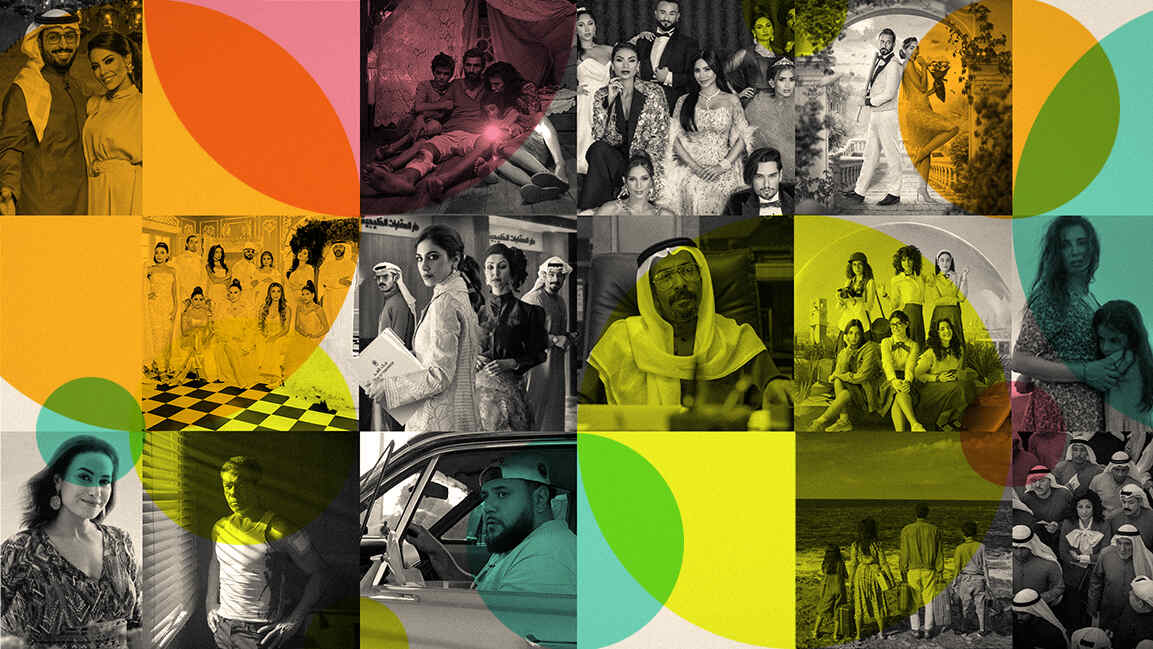- | 9:00 am
Arabic entertainment is leveling up—Here’s why it will dominate screens in the MENA region
Industry experts anticipate this year could see more regional productions to capture the local market, and why co-productions between countries will work best

Not so long ago, we had to endure Orientalist fantasies produced by Hollywood studios because there was no pan-Arab market for Arab cinema and entertainment. Less than 1% of total global online content was in Arabic, and less than 0.2% of global digital content was hosted in the Middle East.
But not anymore. We are witnessing a meteoric rise in productions aimed at regional audiences. Policy reforms combined with investments in infrastructure changed the Arab entertainment landscape immeasurably.
The rise of streamers has given local content a platform that never existed before.
Take, for instance, the groundbreaking Netflix series Mo, which is celebrated for centering Palestinians and its expert balance of drama and comedy while exploring issues around immigration, religion, and language, and Al Rawabi School for Girls depicting the cultural and social shocks young girls experience in high school. The first ever Arabic original Netflix film was released in early 2022, the comedy-drama Perfect Strangers.
These shows, and many others, increased exposure and support for the Arab film industry. Streamers and production houses are ramping up their investments in Arab content, producing and commissioning series and films in the Arab world.
“We’re witnessing an extraordinary creative surge across the Arabic entertainment landscape, and it’s only just beginning,” says Jamie Cooke, General Manager for CEE & EMEA at Warner Bros. Discovery.
“At Warner Bros. Discovery, we see the MENA region as a growth market and a cultural powerhouse with stories that resonate far beyond its borders. The appetite for high-quality, locally produced content—rich in authenticity and deeply rooted in the region’s heritage—is stronger than ever.” Warner Bros. Discovery recently announced an investment in OSN Streaming, a subsidiary of OSN Group. The investment will build on OSN’s growth trajectory and market leadership in MENA’s streaming industry.
Meanwhile, Shahid, backed by MBC Group and with over 27 million monthly active users and a growing appetite for original content, is quickly emerging as the dominant Arabic-language streaming platform.
Now, more than ever, more series and films are being written in Arabic for Arabs by creators who understand the nuance of the region.
AUDIENCES ARE CRAVING AUTHENTICITY
“Audiences are craving authenticity,” says filmmaker Nayla Al Khaja. “For too long, we have consumed stories that didn’t fully reflect our realities or values. Now that we see Arabic content with high production value, compelling plots, and emotionally resonant themes, people are leaning in.”
Al Khaja reiterates that OTT platforms have also opened the floodgates, allowing regional creators to bypass traditional gatekeepers and connect directly with viewers hungry for culturally relevant stories.
“Plus, a sense of pride comes from seeing your language, your dialect, your cities on screen. It is long overdue.”
Elaborating on why Arabic fare in cinemas and OTT is gaining traction in the region, Gianluca Chakra, founder and CEO of Front Row Filmed Entertainment, says global platforms with their western productions and acquisitions penetrate new markets quite regularly, but they quickly reach a plateau of subscribers. “The only way to increase subscribers is to produce local content, as it gives relatability, which people want. They want to relate.”
Contemporary Arabic fares prove that a globalized urban popular culture is at work regardless of the setting.
This January, Netflix, currently the streaming service with the biggest subscriber base across 13 Arabic-speaking countries, announced four new titles that we will be debuting, and this comes in addition to the Arabic content that has already launched this year, including The Sandcastle, Dubai Bling Season 3, and The Exchange Season 2.
Last year, Netflix had a rich slate of content, including AlRawabi School for Girls Season 2, Finding Ola Season 2, Echoes of the Past, Honeymoonish, Saudi Pro League: Kickoff, Love is Blind Habibi, Basma, and From the Ashes, among others. Many of these titles were on Netflix’s top 10 list in the Arab world as well as globally.
Dania Ismail, Director of Strategy and Business Development at Telfaz11, says Arabic film and television production quality has significantly improved in recent years, attracting larger audiences and competing with international productions.
“With the rise of streaming content consumption on platforms like Netflix and Shahid, we are witnessing more intentional and higher investments in original Arabic productions to cater to local preferences and attract subscribers.”
Moreover, she adds that governments across MENA actively support the growth of their local film and television industries through incentives and infrastructure development, which helps foster creativity and increase the production of Arabic content.
There’s a logical evolution of where things are going. Then, of course, there is cinema. The fastest growth is happening in Saudi Arabia, with local cinema continuing to make significant strides as the MENA region’s top movie market.
In 2023, the action-comedy Sattar became the highest-grossing Saudi film ever. In 2024, the thriller Mandoob won critical acclaim and became the biggest Arabic-language film at the Saudi box office. In the last two years, Saudi’s investment in local content has considerably grown.
“We are witnessing a cultural renaissance in Saudi Arabia and across the region,” says Al Khaja. “The shift is not only visible in the sheer volume of content being produced but also in the boldness of the storytelling. There is a newfound appetite for stories that reflect our own identities, our challenges, our humor, and our heritage.”
Saudi Arabia, in particular, has made massive strides, with new infrastructure, funding, and a growing community of creatives stepping into the spotlight.
“It is no longer about waiting for outside validation; we are building our own narratives, and the world is starting to take notice,” Al Khaja adds.
STRONG PRESENCE OF REGIONAL CINEMA
Now, major film festivals such as the Red Sea International Film Festival (RSIFF) have sections and funds dedicated to Arab cinema.
In 2024, 133 films from the MENA region were shown at Cannes. Varying in themes and genres, they had a strong and remarkable presence throughout the competition and other programs of the festival.
In 2023, Four Daughters by the Tunisian director Kaouther Ben Hania was screened in the official competition. Arab films dominated half of the six awards of the Un Certain Regard competition at Cannes.
This year, No Other Land, a film about Palestinians fighting to protect their homes from demolition by Israel’s military, has won the Oscar for Best Documentary Feature.
Surely, all this is a clear sign that the stars are aligning for the region’s often internationally sidelined industry.
If you’re talking about physical infrastructure like studios, many cater to local and international productions. In Saudi Arabia, financially the region’s biggest consumer of entertainment, AlUla, which doubled for Afghanistan in Gerard Butler’s Kandahar, has been home to films, TV series, documentaries, and commercials since 2020. Then, there are Bajdah Studios at NEOM and Al-Hisn Big Time Studios in Riyadh, delivering productions across all formats, genres, and scales.
Multi-billion-dollar Abu Dhabi’s media-free zone, twofour54’s Yas Creative Hub, which spans 2.9 million square feet, including 70,000 sq ft of studio and post-production space, is turning the emirate into a year-round filmmaking destination.
Last year, at the RSIFF in Jeddah, MBC Studios and Telfaz11 Studios, a Riyadh-based content studio that has been instrumental in shaping Saudi cinema, partnered to co-develop and co-produce multiple projects that “celebrate the depth and diversity of Saudi storytelling.”
“We are seeing an increase in Arabic language film productions, and this trend is only going upwards,” says Ismail. “With the increase in infrastructure investment and financing opportunities, we see more talent emerging and more funding and distribution opportunities for them to create compelling content.”
In addition, she says, film festivals, such as the RSIFF, Saudi Film Festival, and Gouna Film Festivals, are playing a major role in driving this content trend forward. “We continue to see more output and variety coming out of the creative community in our region.”
NOT A STRAIGHTFORWARD PATH
Undoubtedly, the value of culture, and local content in particular, has become clear to today’s Arab investors, production houses, and filmmakers, but it is not a straightforward path when broadening Arab cinema’s horizons within the region.
When dealing with talent, Chakra, who closely monitors the many moving parts of the Arabic film scene, says countries are divided. “On one side, you have Egypt, which is considered ‘The Hollywood of the Middle East’ and is known for its cinematic history, which dates back 100 years, but is currently suffering economic turmoil. This means it fully depends on Gulf countries, specifically Saudi Arabia and Kuwait, the two main territories where Egyptian theatrical titles work the most.”
He adds that these same films have great value, beating “hands down” any value imposed by major studios on platforms and networks.
Over the past couple of years, the strength of local content has been one of Saudi Arabia’s greatest trump cards, but Chakra highlights it as a new market with talent used to express through short form and online content made specifically for its market. “Now that cinemas have launched, these known talents among newer ones have started venturing into local Saudi films, which 99.9% of the time do not travel as they are deemed too local even for the Gulf states except one or two feature films.”
Since the local product is strong in Saudi Arabia, the main network in the region is now prioritizing mainly Saudi content, which is fine, Chakra says, if it’s balanced.
He adds: “There is also the problem of shooting there, which is extremely expensive, and the rebate system isn’t exactly flowing as it should, bringing budgets three times more expensive than other more viable countries, making Saudi projects extremely risky.”
He says that co-production between MENA countries would be the perfect solution.
“Then you have Levantine cinema—Jordan, Syria, and Lebanon—which is now being penalized by streamers due to the lack of purchasing power and slim credit card penetration. This clearly affects subscriptions and, therefore, demand and is risking complete extinction or just being boxed into TV shows, which the region is used to.
“Let’s not forget that a country like Lebanon exports much of its content due to its liberalism and relatable stories. Think of celebrated directors like Nadine Labaki and Ziad Doueri.”
Ideally, Chakra adds, MENA countries should start collaborating, using each other’s strengths and positions to create broader Arab content that could eventually travel, develop cross-collateralized incentives between them all, and open the door for larger collaborations.
With a vibrant, economically viable local audience for Arab films to rely on, filmmakers are compelled to ensure their projects are attractive to audiences.
So, if all goes according to plan, Al Khaja says 2025 is going to be a pivotal year, with increased investment, training initiatives, and co-production opportunities. More regional voices will emerge, not just in traditional film but across formats like docuseries, animation, and genre films.
“What excites me most is the diversity within the region itself, from the Gulf to the Levant to North Africa, every corner has a unique story to tell,” she adds. “As creators, we now have the tools and platforms to reach audiences like never before, and I believe local content will dominate screens not only in our region but will also travel far beyond.”
Anticipating a continued increase in the volume and quality of local content, Ismail says Telfaz11 has exciting projects in the pipeline, with a few releases planned for this year. “Additionally, we have several projects in development scheduled for release in 2026 and beyond.”
As Arabic content is primed to take center stage with rapidly advancing production capabilities and a vibrant streaming ecosystem, Cooke says Warner Bros. Discovery is collaborating with regional creators to bring their stories to global audiences. “The next chapter of global entertainment will have the MENA region written into its DNA—and it will be thrilling to watch it unfold.”
While this year could see more regional productions to capture the local market, Chakra says it should also be about learning from past deficits and mistakes and organically strategizing with content per country.
“The bigger picture would be finally making an Arab film that all MENA countries could relate to and eventually have those travel more and more.”







































